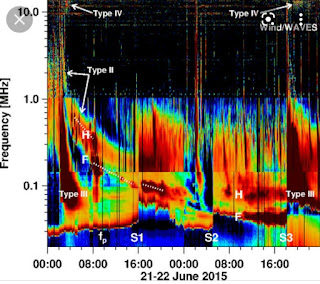We are witnessing Type-II and Type-IV emission periods...Thus,I frequently continue satisfying informations public
Type II
Type II bursts exhibit a relatively slow drift from high to low frequencies of around 1 MHz per second, typically over the course of a few minutes.They often exhibit two distinct bands of emission that correspond to fundamental and harmonic plasma emission emanating from the same region. Type II bursts are associated with coronal mass ejections (CMEs) and are produced at the leading edge of a CME, where a shock wave accelerates the electrons responsible for stimulating plasma emission.The frequency drifts from higher to lower values because it depends on the electron density, and the shock propagates outward away from the Sun through lower and lower densities. By using a model for the Sun's atmospheric density, the frequency drift rate can then be used to estimate the speed of the shock wave. This exercise typically results in speeds of around 1000 km/s, which matches that of CME shocks determined from other methods.
While plasma emission is the accepted mechanism, Type II bursts do not exhibit significant amounts of circular polarization as would be expected by standard plasma emission theory.The reason for this is unknown, but a leading hypothesis is that the polarization level is suppressed by dispersion effects related to having an inhomogeneous magnetic field near a magnetohydrodynamic shock.Type II bursts sometimes exhibit fine structures called herringbone bursts that emanate from the main burst, as it appears in a dynamic spectrum, and extend to lower frequencies. Herringbone structures are believed to result from shock-accelerated electrons that were able to escape far beyond the shock region to excite Langmuir waves in plasma of lower density than the primary burst region.
Type IV
Type IV bursts are spikes of broad-band continuum emission that include a few distinct sub-types associated with different phenomena and different emission mechanisms. The first type to be defined was the moving Type IV burst, which requires imaging observations (i.e. interferometry) to detect.They are characterized by an outward-moving continuum source that is often preceded by a Type II burst in association with a coronal mass ejection (CME).The emission mechanism for Type IV bursts is generally attributed to gyrosynchrotron emission, plasma emission, or some combination of both that results from fast-moving electrons trapped within the magnetic fields of an erupting CME.
Stationary Type IV bursts are more common and are not associated with CMEs.They are broad-band continuum emissions associated either with solar flares or Type I bursts.Flare-associated Type IV bursts are also called flare continuum bursts, and they typically begin at or shortly after a flare's impulsive phase. Larger flares often include a storm continuum phase that follows after the flare continuum.The storm continuum can last from hours to days and may transition into an ordinary Type I noise storm in long-duration events.Both flare and storm continuum Type IV bursts are attributed to plasma emission, but the storm continuum exhibits much larger degrees of circular polarization for reasons that are not fully known.
Important points as Visual;
Informative links;
https://www.astro.gla.ac.uk/users/eduard/cesra/?p=2143
https://discount.cheapsalesstore2022.ru/category?name=solar%20radio%20bursts





Yorumlar
Yorum Gönder